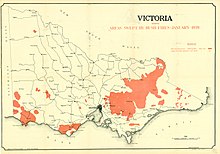| Black Friday bushfires | |
|---|---|
 A map of Victoria showing the impact of the Black Friday bushfires as shaded, that burnt on 13 January 1939. (Source: State Library of Victoria) | |
| Date(s) | 13 January 1939 |
| Location | Victoria, Australia |
| Statistics | |
| Burned area | 2,000,000 hectares (4,900,000 acres) |
| Impacts | |
| Deaths | 71 |
| Structures destroyed | 650 |
| Ignition | |
| Cause |
|
The Black Friday bushfires of 13 January 1939, in Victoria, Australia, were part of the devastating 1938–1939 bushfire season in Australia, which saw bushfires burning for the whole summer, and ash falling as far away as New Zealand. It was calculated that three-quarters of the State of Victoria was directly or indirectly affected by the disaster, while other Australian states and the Australian Capital Territory were also badly hit by fires and extreme heat. This was the third-deadliest bushfire event in Australian history, only behind the 1983 Ash Wednesday bushfires and the 2009 Black Saturday bushfires.[1]
Fires burned almost 2,000,000 hectares (4,900,000 acres) of land in Victoria, where 71 people were killed, and several towns were entirely obliterated. Over 1,300 homes and 69 sawmills were burned, and 3,700 buildings were destroyed or damaged.[2] In response, the Victorian state government convened a Royal Commission that resulted in major changes in forest management. The Royal Commission noted that "it appeared the whole State was alight on Friday, 13 January 1939".[3]
New South Wales and the Australian Capital Territory also faced severe fires during the 1939 season. Destructive fires burned from the NSW South Coast, across the ranges and inland to Bathurst, while Sydney was ringed by fires which entered the outer suburbs, and fires raged towards the new capital at Canberra.[4] South Australia was also struck by the Adelaide Hills bushfires.
- ^ Williams, Liz T. (3 November 2011). "The worst bushfires in Australia's history". Australian Geographic. Retrieved 27 January 2020.
- ^ Cite error: The named reference
:84was invoked but never defined (see the help page). - ^ Lewis, Wendy; Balderstone, Simon; Bowan, John (2006). Events That Shaped Australia. New Holland. pp. 154–158. ISBN 978-1-74110-492-9.
- ^ "Terrible Climax to Heatwave". The Sydney Morning Herald. 16 January 1939.